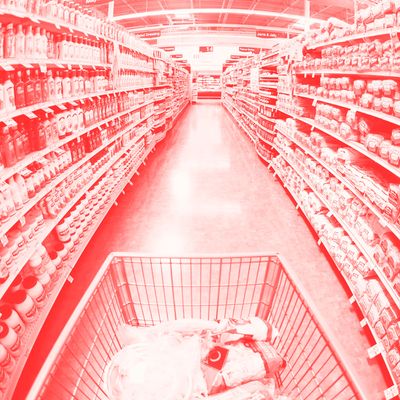
“Eat real food” is simple-seeming dietary advice that’s actually anything but. On the one hand, it sounds easy enough: Unlike some Goop-approved detox, it’s a guideline that appears to leave room for most food groups. On the other hand, though, “real food” is a slippery concept, one without any single established definition. And without a universal understanding of what the term describes, many people just use “real food” to mean the opposite of “processed food” — a dichotomy that doesn’t do anybody any favors.
That’s because most of us don’t have a clear understanding of what “processed food” means, either. Many foods we like to think of as “whole” and “natural” undergo a fair amount of processing. As food scientist Robert Shewfelt explains in his book In Defense of Processed Food, baby carrots have to be de-leaved, washed, disinfected with chlorine, chilled, cut, peeled, and polished prior to bagging. Bagged salads are shredded and triple washed, also with chlorine. Most milk in the U.S. is fortified, homogenized, and pasteurized, and that’s a good thing, as pasteurization greatly reduces the risk of foodborne illness. Some crops, like leafy greens, are more susceptible to pathogens, and processing helps get them clean (clean in the literal sense, by the way, not the meaningless way it’s deployed in Panera Bread ads). Freezing, a form of processing, can preserve nutrients, whereas fresh fruits and vegetables begin to lose those nutrients under all sorts of conditions, including exposure to heat, rough handling, and refrigeration.
And while “processed food” may sound like a modern-day invention, nothing could be farther from the truth. The history of processed food actually begins 1.8 million years ago, when our ancestors began roasting meat; two later examples are bread and beer.
Katherine Pett, a registered dietician who writes for the blog Nutrition Wonk, finds the term “processed food” far too nebulous. “Various experts who promote different ways of eating or their own food products [all] have different definitions of what constitutes processed food,” she says. The category definitely includes chips, crackers, and cookies, but it also include things like canned tomatoes, dried pasta, and hummus.
In his book In Defense of Processed Food, Robert Shewfelt defines processed food as “a product that has been modified to improve its safety, extend the shelf life, enhance its quality, and improve its convenience.” Processing can also open up our diets to healthy foods that might otherwise be too time-consuming or difficult to make: Beans, for example, require overnight soaking and hours of cooking, unless they’re the canned, processed kind you find on grocery-store shelves (as Pett explains, “buying a can of beans is a good [easy] way to introduce [beneficial legumes]”). The advent of bagged lettuce, meanwhile, likely led to an increase in our consumption of healthy leafy greens.
Unprocessed food, then, isn’t necessarily better. And as food historian Rachel Laudan notes in her essay “A Plea for Culinary Modernism,” processing can improve the flavor of healthy foods, too: “For our ancestors, natural was something quite nasty. Natural often tasted bad,” she writes. “Fresh meat was rank and tough, fresh milk warm and unmistakably a bodily excretion; fresh fruits (dates and grapes being rare exceptions outside the tropics) were inedibly sour, fresh vegetables bitter.”
But what about the chemicals? you might be thinking. Well, technically, everything is a chemical. Just look at the makeup of this all-natural banana: all chemicals. And organic pop tarts and non-GMO chips aren’t any healthier, or less processed, than those made by Kellogg’s or Lay’s.
Weighing the health risk of certain ingredients, it’s important to remember that old maxim: The dose makes the poison. Most preservatives, additives, and other chemicals in our food are present only in trace amounts that aren’t dangerous or unhealthy. For example, a July 2017 New York Times article on boxed macaroni and cheese warned consumers about the presence of dangerous phthalates, but what the article didn’t explain is that the levels detected were minuscule. You’d have to eat many, many boxes of macaroni every day before they could pose any sort of health threat.
In part, our suspicion of processed foods is about nostalgia, too. The new-old trend of pickling and home canning, for example, doesn’t make the end result any healthier just because the processing happens in your kitchen. And while we tend to feel better about homemade cookies and cakes, they usually aren’t any healthier than store-bought, “processed” cookies; their advantage comes from the fact that they connect us to familial and cultural traditions.
It’s worth noting, though, that this nostalgia isn’t harmless: “While family meals of wholesome, home-cooked foods are increasingly romanticized,” as environmental historian Jennifer Bernstein wrote in an article in the journal Breakthrough earlier this year, “it’s likely that they are romanticized by those on the receiving end of those meals.” And as Shewfelt has noted, “shelf stable foods, the development of ready-to-eat products, and use of microwave ovens dramatically decreased food preparation times which may have contributed to the entry of more women to the workforce.”
And besides, the nostalgia can cut both ways. Consumers recently rejected an all-natural, artificial dye-free version of Trix breakfast cereal, for example, because it just didn’t look like the Trix they knew.
Which is just one more example of how our relationship to “processed food” can be strange, complicated, and irrational, shaped as much by what we feel as by what we know. I’m a perfect example: I happened to grow up on the sort of no-sugar, cardboard-flavored cookies you find in health stores, so even though my rational brain understands that the organic pastry tarts aren’t any healthier than Kellogg’s Pop Tarts, I still can’t manage to feed my kids anything with neon-blue frosting. I mean, it just looks so unnatural. I know better, but it’s a hard feeling to shake.




